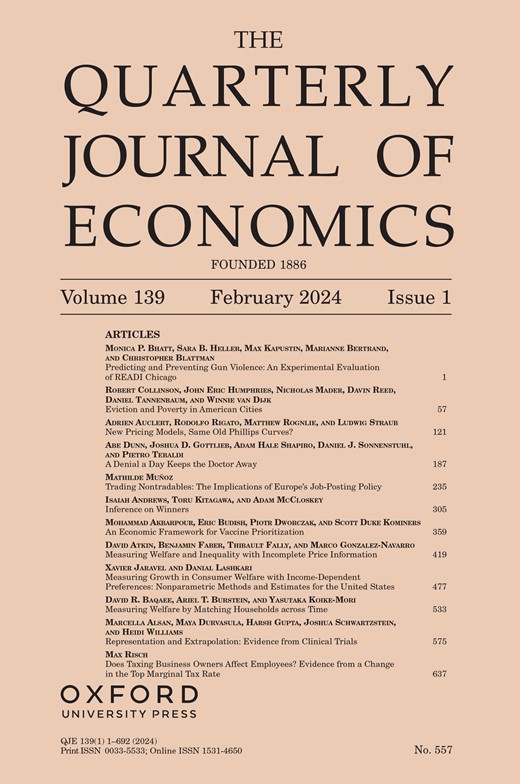COVID-19的经济影响:来自利用私营部门数据建立的新公共数据库的证据
IF 12.7
1区 经济学
Q1 ECONOMICS
引用次数: 2
摘要
我们建立了一个公开可用的数据库,使用来自私营公司的匿名数据,实时跟踪美国的经济活动。我们每周报告消费者支出、商业收入、工作岗位和就业率的统计数据,这些数据按县、部门和收入群体分类。利用可公开获得的数据,我们通过分析各子群体影响的异质性,展示了COVID-19大流行对经济的影响。高收入人群在2020年3月大幅减少了支出,特别是在需要面对面互动的行业。这种支出的减少大大减少了富裕、人口稠密地区小企业的收入。这些企业解雇了许多员工,导致大规模失业,特别是在这些地区的低薪工人中。高工资工人经历了持续数周的“v型”衰退,而低工资工人则经历了更大、更持久的失业。尽管到2021年12月,消费者支出和就业岗位已经完全恢复,但在最初受到重创的地区,低薪工作的就业率仍然低迷,这表明劳动力需求的暂时下降导致了劳动力供应的持续减少。在此诊断分析的基础上,我们评估了旨在遏制经济活动螺旋式下滑的财政刺激政策的影响。现金刺激支出在大流行初期导致支出大幅增加,但在大流行后期的反应却小得多,特别是对高收入家庭而言。对边际消费倾向的实时估计,可以比历史估计更好地预测后续几轮刺激支出的影响。总体而言,我们的研究结果表明,财政政策可以阻止消费者支出和失业的二次下降,但当消费者支出的最初冲击源于健康问题时,财政政策无法恢复充分就业。更广泛地说,我们的分析表明,从私营部门数据构建的公共统计数据如何支持许多研究和实时政策分析,为实证宏观经济学提供了一种新工具。本文章由计算机程序翻译,如有差异,请以英文原文为准。
THe Economic Impacts of COVID-19: Evidence from a New Public Database Built Using Private Sector Data
Abstract We build a publicly available database that tracks economic activity in the U.S. at a granular level in real time using anonymized data from private companies. We report weekly statistics on consumer spending, business revenues, job postings, and employment rates disaggregated by county, sector, and income group. Using the publicly available data, we show how the COVID-19 pandemic affected the economy by analyzing heterogeneity in its impacts across subgroups. High-income individuals reduced spending sharply in March 2020, particularly in sectors that require in-person interaction. This reduction in spending greatly reduced the revenues of small businesses in affluent, dense areas. Those businesses laid off many of their employees, leading to widespread job losses, especially among low-wage workers in such areas. High-wage workers experienced a “V-shaped” recession that lasted a few weeks, whereas low-wage workers experienced much larger, more persistent job losses. Even though consumer spending and job postings had recovered fully by December 2021, employment rates in low-wage jobs remained depressed in areas that were initially hard hit, indicating that the temporary fall in labor demand led to a persistent reduction in labor supply. Building on this diagnostic analysis, we evaluate the impacts of fiscal stimulus policies designed to stem the downward spiral in economic activity. Cash stimulus payments led to sharp increases in spending early in the pandemic, but much smaller responses later in the pandemic, especially for high-income households. Real-time estimates of marginal propensities to consume provided better forecasts of the impacts of subsequent rounds of stimulus payments than historical estimates. Overall, our findings suggest that fiscal policies can stem secondary declines in consumer spending and job losses, but cannot restore full employment when the initial shock to consumer spending arises from health concerns. More broadly, our analysis demonstrates how public statistics constructed from private sector data can support many research and real-time policy analyses, providing a new tool for empirical macroeconomics.
求助全文
通过发布文献求助,成功后即可免费获取论文全文。
去求助
来源期刊

Quarterly Journal of Economics
ECONOMICS-
CiteScore
24.20
自引率
2.20%
发文量
42
期刊介绍:
The Quarterly Journal of Economics stands as the oldest professional journal of economics in the English language. Published under the editorial guidance of Harvard University's Department of Economics, it comprehensively covers all aspects of the field. Esteemed by professional and academic economists as well as students worldwide, QJE holds unparalleled value in the economic discourse.
 求助内容:
求助内容: 应助结果提醒方式:
应助结果提醒方式:


